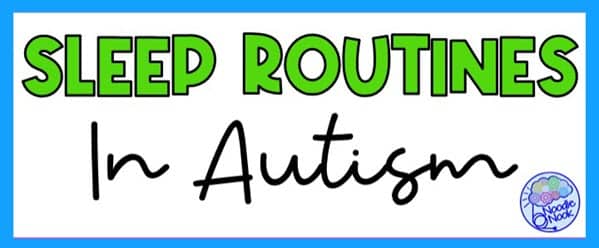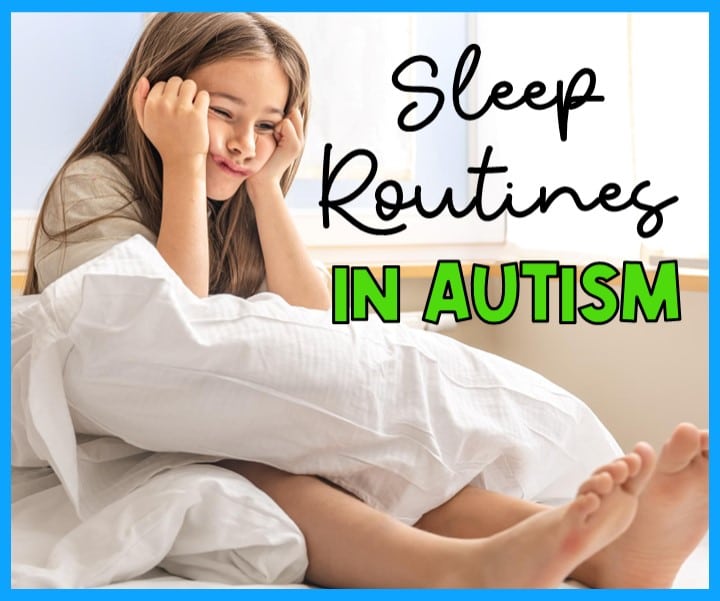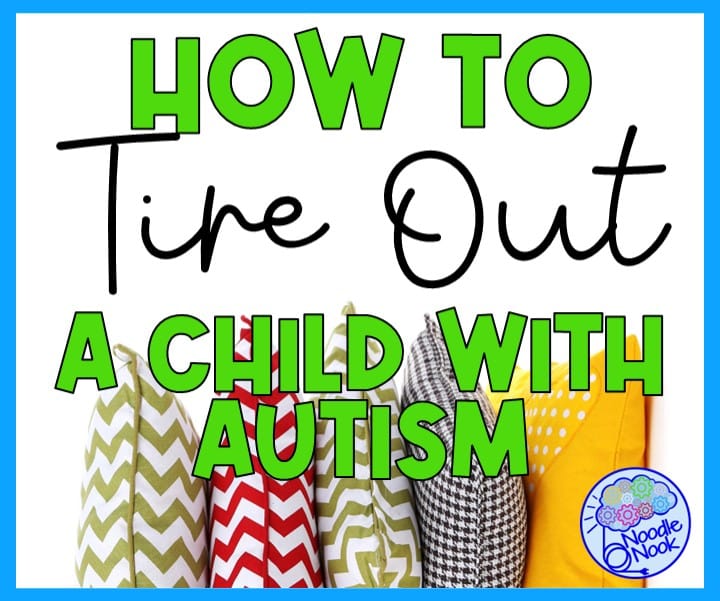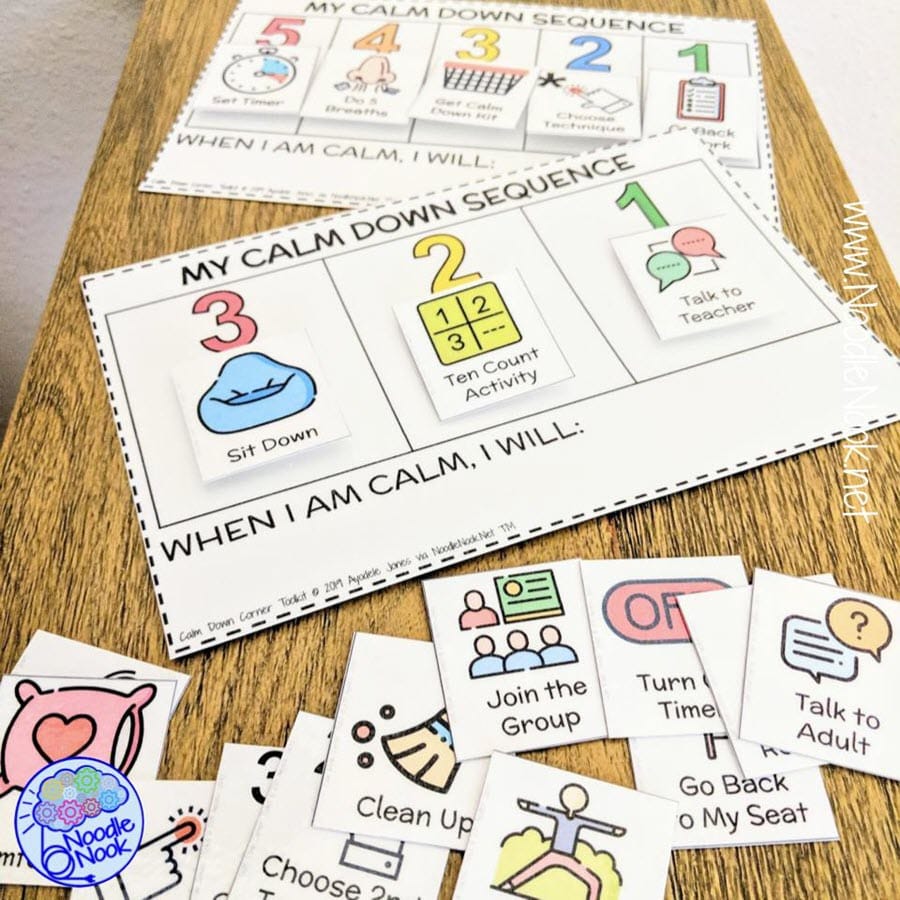Every day I had a student who would sleep through most of the school day. When we tried to wake him up, things turned violent quickly. After a while, my team just accepted the fact that he was not going to be awake at school. Around his annual IEP meeting, I had a deep and intensive talk with his mother. Turns out she was at her wit’s end dealing with her autistic son, who was up all in the middle of the night rummaging through the house and getting into things. She was about to lose her job, felt like she couldn’t date, and was just miserable. So we set out together to attack their sleep routines and figure out how to tire out an autistic child who had somehow turned nocturnal.
ASD and Sleep
ASD stands for Autism Spectrum Disorder. It is a neurological and developmental disorder that affects communication, social interaction, and behavior. Sleep disturbances are very common in those with ASD. They can be caused by a variety of factors including difficulties with relaxing or winding down, sensory processing issues, comorbid conditions such as anxiety and ADHD, and medication side effects.
Studies suggest that individuals with ASD may carry mutations that affect levels of melatonin, a natural hormone that controls sleep. Furthermore, sleep problems in ASD have been correlated with increased maternal stress and parental sleep disruption.
It is important to address sleep disturbance in individuals with ASD, as good quality sleep is essential for overall health and well-being.
How Autism Affects Sleep
Sleep is essential for everyone’s overall health and well-being. For children with ASD, getting a good night’s sleep can be a real struggle. Research shows that up to 80% of children with ASD experience sleep problems. This can result in a range of issues such as fatigue, irritability, and poor concentration during the day. Autistic people may struggle with sensory issues, social situations, and levels of anxiety. These things can make it hard for them to wind down and fall asleep at night.
Additionally, some children with ASD have medical problems that affect their sleep, such as sleep apnea or restless leg syndrome. With so many factors impacting their sleep, it’s no wonder that many parents and educators are at a loss when it comes to establishing effective sleep routines for their children with autism.
Common Sleep Disorders in ASD
There are several common sleep disorders that individuals with ASD may experience. These impact their quality of life, mental acuity, and capacity for learning. They including:
- Insomnia: Difficulty falling asleep or staying asleep.
- Sleep Apnea: A breathing disorder that causes interruptions in breathing during sleep, leading to poor sleep quality.
- Restless Leg Syndrome: An uncontrollable urge to move the legs that can disrupt sleep.
- Circadian Rhythm Disorders: A disruption in the body’s natural sleep-wake cycle, causing sleep disturbances and daytime sleepiness.
- Parasomnias: Abnormal behaviors during sleep, such as sleepwalking or night terrors, that can disrupt sleep.
- Bruxism: Grinding or clenching of the teeth, which can lead to disrupted sleep and other dental problems.
It is important to work with healthcare professionals to properly diagnose and treat any sleep disorders in individuals with ASD. Remember, better sleep can lead to improved overall health and quality of life.
The Importance of Good-Quality Sleep for Children With ASD
Good-quality sleep is essential for children with ASD because it can have a significant impact on their mental health, behavior, and overall well-being. Studies have shown that poor sleep quality can exacerbate existing symptoms such as hyperactivity, irritability, and anxiety.
Additionally, sleep disturbances can affect a child’s ability to concentrate, learn, and interact with others, making it harder to succeed academically and socially. By promoting good sleep hygiene and addressing any sleep disorders, parents and caregivers can help children with ASD get the restorative sleep they need to thrive.
How Lack of Sleep Impacts Learning
Lack of sleep can have a significant impact on learning. When we sleep, our brains consolidate memories and process information learned during the day. If we don’t get enough sleep, this memory consolidation process can be disrupted, and we may have difficulty retaining information.
On top of that, lack of sleep can impair attention, concentration, and decision-making, making learning more difficult. Studies have shown that sleep-deprived individuals also have a harder time learning new information and retaining it long-term. In children, chronic sleep deprivation can even lead to cognitive deficits and developmental delays. Therefore, it is important to prioritize good sleep hygiene and get enough restful sleep to support optimal learning and cognitive function.
How Lack of Sleep Impacts the Family
Lack of sleep can have a significant impact on families. It can lead to increased stress, irritability, and tension among family members. When one family member is not getting enough sleep, it can also affect the sleep of other family members. That may be because they are easily disturbed by the noise or disruptions caused by the sleep-deprived family member.
This can create a cycle of disrupted sleep for the entire family, leading to even more stress and tension. That was certainly true for the parent that sparked this blog post. And what was also true for her was that her lack of sleep really affected the family dynamics. That included making it harder for family members to communicate and work together effectively. Therefore, it is important for families to prioritize good sleep hygiene and support each other in getting enough restful sleep.
The Importance of a Sleep Routine
Why Having a Regular Bedtime is Important
Having a regular bedtime is important for children with autism because they tend to have difficulty falling and staying asleep. Establishing a consistent sleep routine can help create a sense of predictability in family routines and promote relaxation, making it easier for children to fall asleep.
Additionally, a regular bedtime can help regulate the body’s circadian rhythm and improve overall sleep quality. Seeking guidance from healthcare professionals and incorporating sensory-based interventions, such as physical activities, deep pressure techniques, and minimizing screen time, can all play a role in promoting a positive sleep environment for children with autism. Consistent sleep routines can improve overall health and well-being for children with autism, allowing them to better engage in daily activities and reach their full potential.
The Impact of Electronic Devices on Sleep Quality
The use of electronic devices can have a significant impact on sleep quality in individuals with ASD. The blue light emitted by electronic screens can suppress the production of melatonin, a hormone that helps regulate sleep, making it more difficult for individuals with ASD to fall asleep and stay asleep. And time on screen is a huge issue for most Americans these days, especially older children.
The stimulating nature of electronic devices can make it harder for individuals with ASD to relax and transition into a restful state. It is important to be mindful of screen time and incorporate strategies to minimize its use, such as establishing screen-free times before bedtime or using filtering software to reduce blue light exposure. Seeking guidance from healthcare professionals can provide more targeted and individualized solutions for promoting healthy sleep habits in individuals with ASD.
Sensory Input and It’s Effect on Sleep
Sensory input refers to the information that our brain receives through our senses, such as touch, sight, sound, taste, and smell. Sensory input can have both positive and negative effects on sleep in individuals with ASD.
On one hand, sensory-based interventions such as deep pressure techniques can promote relaxation and improve sleep quality. On the other hand, excessive or uncomfortable sensory input, such as noise or bright lights, can make it harder for individuals with ASD to fall asleep and stay asleep. That’s why it’s so important to take a holistic approach to sleep challenges in autistic kids and those with special needs to help find the best way to address sleep.
Examples of Sleep Routines and How to Implement Them
There are many different examples of sleep routines that can be implemented to promote healthy sleep habits. Some common components of a sleep routine include establishing a consistent bedtime and wake-up time, creating a relaxing bedtime environment, avoiding stimulating activities before bed, and incorporating calming activities such as reading a book or doing gentle stretches.
Other helpful strategies might include aromatherapy, deep breathing exercises, and sensory-based interventions such as using a weighted blanket or engaging in deep pressure techniques.
As a teacher, there are several ways to support a sleep routine from the classroom, whether families are able to provide support at home or not. One approach might be to create a calming classroom environment that promotes relaxation, such as dimming the lights and playing soft music during nap time.
Teachers can also establish consistent nap times and routines for children to follow at school when it is time to nap. Encouraging physical activity and outdoor play during the day can also help promote healthy sleep habits by helping children use up excess energy.
Additionally, teachers can provide resources to parents such as literature or educational material on healthy sleep habits and share strategies that have been successful in the classroom. We know in order to make a sleep plan work, we need parents and families to reinforce plans at home. That means collaboration will help, but even without it a teacher can be proactive.
Physical Activities to Tire Out Children with Autism
Getting physical can provide numerous benefits for children with ASD. Physical activities such as running, jumping, and climbing can help to improve coordination and balance, which is often a challenge for children with ASD. What’s more, regular physical activity can help children with ASD to release pent-up energy, which can help to reduce stress and anxiety, both of which are common issues for children with ASD. Ultimately, and why physical activity is so important for this topic, physical activity can improve sleep. It can help them to fall asleep faster and stay asleep longer, which can enhance their overall health and wellbeing.
What are the Benefits of Physical Activities in Children with Autism
Physical activity has been shown to have several benefits for children with autism. This is something you can do in the classroom or with outdoor activities. Being outdoors increases a child’s exposure to the sun and increases how much light they get and can convert into dopamine. A recent study has indicated that how much time is spent outdoors can impact sleep. In addition, there are significant benefits to physical activity, including:
- Improving motor skills: Deficiencies in motor skills are common in children with ASD, and physical activity has been shown to improve motor skills.
- Reducing maladaptive behaviors: Physical activity can help reduce maladaptive behaviors such as self-stimulation, aggression, and stereotyped behaviors.
- Improving social functioning: Physical activity can help improve social interaction and communication skills in children with autism.
- Improving cardiovascular fitness: Participation in physical activities can have a positive effect on the health and cardiovascular fitness of children with ASD.
- Improving overall quality of life: Physical activity can lead to improved physical and mental health, increased self-esteem, and better sleep, all of which can contribute to a better quality of life for children with autism.
It is important to note that every child is unique, and that the benefits of physical activity may vary from child to child. Therefore, it is important to find physical activities that are appropriate and beneficial for each child.
Fine Motor Activities that Improve Sleep
There is limited research on the specific link between fine motor activities and sleep. However, fine motor activities can help with overall physical and mental health, which can contribute to better quality sleep.
Here are some examples of fine motor activities that may be beneficial for overall health and potentially improve sleep:
- Coloring, drawing, or painting.
- Crafts such as knitting, crocheting, or sewing.
- Playing with small objects such as beads or blocks.
- Manipulating playdough or clay.
- Puzzle building or playing with building blocks.
In the classroom, these tasks are easy to integrate into the classroom routine. Plus, engaging in calming fine motor activities such as coloring or knitting before bedtime may help promote relaxation and better sleep.
Classroom Activities that Improve Sleep
As previously mentioned, there is limited research on specific classroom activities that improve sleep for students with ASD. However, here are some strategies that may help promote healthy sleep habits in the classroom:
- Establish a consistent routine for the classroom, with set times for activities and transitions. This can help create a sense of predictability and routine that can promote relaxation and better sleep.
- Provide opportunities for physical activity during the day, such as movement breaks or outdoor playtime. Exercise has been shown to improve sleep quality in children.
- Incorporate mindfulness or relaxation exercises into the day, such as deep breathing exercises or quiet reflective time. This can help students learn to calm their minds and bodies and may promote better sleep habits. Try these positive self-talk worksheets!
- Create a calm and low-stimulus environment in the classroom, with minimal noise and visual distractions. This can help students feel more relaxed and reduce stress levels. Then consider a calm down corner.
- Avoid serving sugary foods or drinks during the day, particularly in the afternoon leading up to bedtime.
Remember, promoting healthy sleep habits is important for the overall well-being and success of children. That means implementing these strategies as well as visual cues/visual aid and supports, quiet activities, and energy levels as part of a child’s routine. But this is a team effort and in order to support good sleep in the home environment you’ll need help. You have to work with families and parents of children with autism to implement a comprehensive plan for healthy sleep habits both in and out of the classroom.
Heavy Weight Activates in the Classroom
There are several heavy work activities that teachers can incorporate in the classroom to support students with ASD who may benefit from proprioceptive input. Proprioceptive input involves activities that use pressure on the muscles and joints to provide sensory feedback to the body. Some examples of heavy work activities that teachers can use in the classroom with students with ASD include:
- Pushing a heavy cart or trolley around the classroom.
- Carrying books or weighted backpacks.
- Wall push-ups or chair push-ups.
- Squeezing a stress ball or Theraband.
- Tearing paper or cardboard.
- Using resistance bands for arm exercises.
- Heavy lifting of objects, such as books or boxes.
It is important to keep in mind that heavy work activities should be tailored to the individual student’s needs, preferences, and sensory profile. It is also important to provide a calm and structured environment to avoid overstimulation and to implement the activities under the guidance of an occupational therapist or healthcare professional.
Extra Ways to Improve Sleep
What are Deep Pressure Techniques and How Do They Help?
Deep pressure techniques are believed to help people with sensory processing difficulties, including individuals with ASD, by providing calming and regulating sensory input to the body. Proprioceptive input, which is the sensory information obtained through deep pressure, helps to regulate the nervous system, promote relaxation, and improve body awareness.
This can have a positive impact on the individual’s overall sensory processing, mood, attention, and sleep quality. Deep pressure techniques are thought to mimic the effects of a hug, which can be comforting and provide a sense of security.
By incorporating deep pressure techniques into a daily routine, individuals with ASD can develop better sensory self-regulation skills, which can be beneficial for improving sleep quality and overall well-being. However, it is important to work in collaboration with an occupational therapist or healthcare professional to determine the most appropriate and safe use of deep pressure techniques for each individual.
Occupational Therapist Techniques for Deep Pressure
There are several occupational therapy techniques that involve deep pressure and can potentially support better sleep for students with ASD. Here are a few examples:
- Use of a weighted blanket or weighted vest – The deep pressure provided by a weighted blanket or vest can help promote relaxation and calmness, potentially improving sleep quality.
- Compression garments – Compression garments such as compression vests or snug-fitting clothing can provide deep pressure and proprioceptive input to the body, which can help regulate the sensory system and promote better sleep.
- Massage or deep pressure touch – Massage or deep pressure touch can provide calming and relaxing sensory input that may improve sleep quality.
- Use of a therapy ball or therapy cushion – Sitting on a therapy ball or cushion can provide deep pressure input to the body, which may help promote relaxation and improve sleep.
It is important to remember that the effectiveness of these techniques can vary from student to student and should be tailored to individual needs and preferences. It is also important to consult with an occupational therapist or healthcare professional for guidance on implementing these techniques safely and effectively.
Weighted Blankets and Deep Pressure
Weighted blankets are blankets that are filled with materials such as plastic pellets, rice, or sand to make them heavier than traditional blankets. The weight of the blanket provides deep pressure input to the body, which can help promote relaxation and calmness. The pressure from the blanket is thought to stimulate the release of serotonin and melatonin, which are the body’s natural mood and sleep regulators. Weighted blankets have been found to be effective for reducing anxiety, improving sleep quality, and providing comfort for individuals with sensory processing difficulties, including those with ASD.
In the classroom, weighted blankets can be used as part of a sensory diet or sensory tool kit to help regulate students’ sensory systems and promote better focus and relaxation. Students can use the blankets during quiet reading time or during relaxation exercises to help them calm down and feel more comfortable. It is important to note that the use of weighted blankets should always be supervised by a trained occupational therapist or healthcare professional to ensure the safety and effectiveness of the technique for each individual student’s needs and preferences.
Using Essential Oils or Noise Machines
Using essential oils or noise machines in the classroom can potentially support better sleep for students with ASD by providing calming sensory input to the body. Essential oils such as lavender or chamomile can be used in sprays or lotions or added to a diffuser to provide a relaxing aroma, which can help promote relaxation and improve sleep quality. A white noise machine can be used to mask disruptive sounds and provide a calming background noise, which can also promote relaxation and improve sleep. However, it is important to recognize that individual responses to sensory inputs can vary and that not all individuals with ASD will benefit from the same strategies. It is also important to work with a healthcare professional when incorporating sensory-based interventions into the classroom, as they can provide guidance on the safe and effective use of these strategies.
RECAP: How to Tire Out Children with Autism in the Classroom
Good quality sleep is crucial for autistic children, and there are various strategies that teachers can employ to help improve their students’ sleep routines. Physical activities, deep pressure techniques, and minimizing screen time can all play a role in promoting relaxation and better sleep. Being mindful of sensory preferences, working with parents and special education staff, and seeking guidance from healthcare professionals can all help create a positive sleep environment for autistic children. It’s important to remember that a good night’s sleep is not an impossible dream for these children, but rather a vital component of their overall health and well-being. By incorporating these strategies into the classroom routine, it is possible to support autistic children at home. Together, we can implement a child’s bedtime routine, which is a game changer in improving classroom behavior and helping a child (and their family) get a decent night’s sleep.
References
Devnani, P. A., & Hegde, A. U. (2015). Autism and sleep disorders. Journal of pediatric neurosciences, 10(4), 304-307. doi: https://doi.org/10.4103/1817-1745.174438
Furfaro, H. (2020, 02 06). Sleep problems in autism, explained. Retrieved from Spectrum News: https://www.spectrumnews.org/news/sleep-problems-autism-explained/
National Autistic Society. (2020, 08 20). Sleep and autism. Retrieved from Autism.org.uk: https://www.autism.org.uk/advice-and-guidance/topics/physical-health/sleep
Yarımkaya, E., & Esentürk, O. K. (2022). Promoting physical activity for children with autism spectrum disorders during Coronavirus outbreak: benefits, strategies, and examples. International Journal of Developmental Disabilities, 68(4), 430-435. Retrieved from https://www.tandfonline.com/doi/full/10.1080/20473869.2020.1756115




